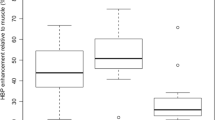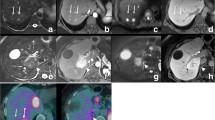Abstract.
The aim of this study was to evaluate capabilities of pulse inversion harmonic imaging (PIHI) with Levovist in detection of liver metastases compared with conventional ultrasound (US) and helical CT (HCT). One hundred sixty consecutive patients with known malignancies were evaluated by conventional US, PIHI 2 min (40 patients) or 4 min (120 patients) after Levovist injection and HCT. Conspicuity and number of the identified metastatic lesions were evaluated and assessed by statistical analysis (significance p<0.05). Mean diameter of the smallest identified metastases was computed for conventional US, PIHI and HCT. In cases where PIHI revealed more lesions suspicious for metastases than HCT, intraopertive US with surgical biopsy or 3–6-month US follow-up were performed to confirm diagnosis. Images were stored on magneto-optical disk and evaluated off-line by a dedicated software. Metastases conspicuity was significantly improved on PIHI if compared with conventional US (p<0.05). In 49 patients all the employed imaging techniques did not reveal any lesion, whereas in the remaining 111 patients, 28 patients revealed more than five metastatic lesions and 83 patients presented from one to five metastatic lesions. In comparison with conventional US, PIHI revealed more metastases in 39/83 (47%), the same number in 44/83 (53%) and a lower number in 0/83 (0%) patients. In comparison with HCT, PIHI revealed more metastases in 10/83 (12%), the same number in 61/83 (74%) and a lower number in 12/83 (14%) patients. Average number ± SD (standard deviation) of confirmed metastases for patients was 2.21±1.6 for conventional US, 3.1±2.44 for PIHI and 3.05±2.41 for HCT. The difference between PIHI and conventional US was statistically significant (p<0.0001), whereas the difference between PIHI and HCT was not significant (p=0.9). The smallest identified metastases presented 3-mm mean diameter on PIHI, 5-mm on HCT and 7-mm on conventional US. PIHI with Levovist is a reliable technique in metastases detection.
Similar content being viewed by others
Author information
Authors and Affiliations
Additional information
Electronic Publication
Rights and permissions
About this article
Cite this article
Quaia, E., Bertolotto, M., Forgács, B. et al. Detection of liver metastases by pulse inversion harmonic imaging during Levovist late phase: comparison with conventional ultrasound and helical CT in 160 patients. Eur Radiol 13, 475–483 (2003). https://doi.org/10.1007/s00330-002-1670-1
Received:
Revised:
Accepted:
Issue Date:
DOI: https://doi.org/10.1007/s00330-002-1670-1




